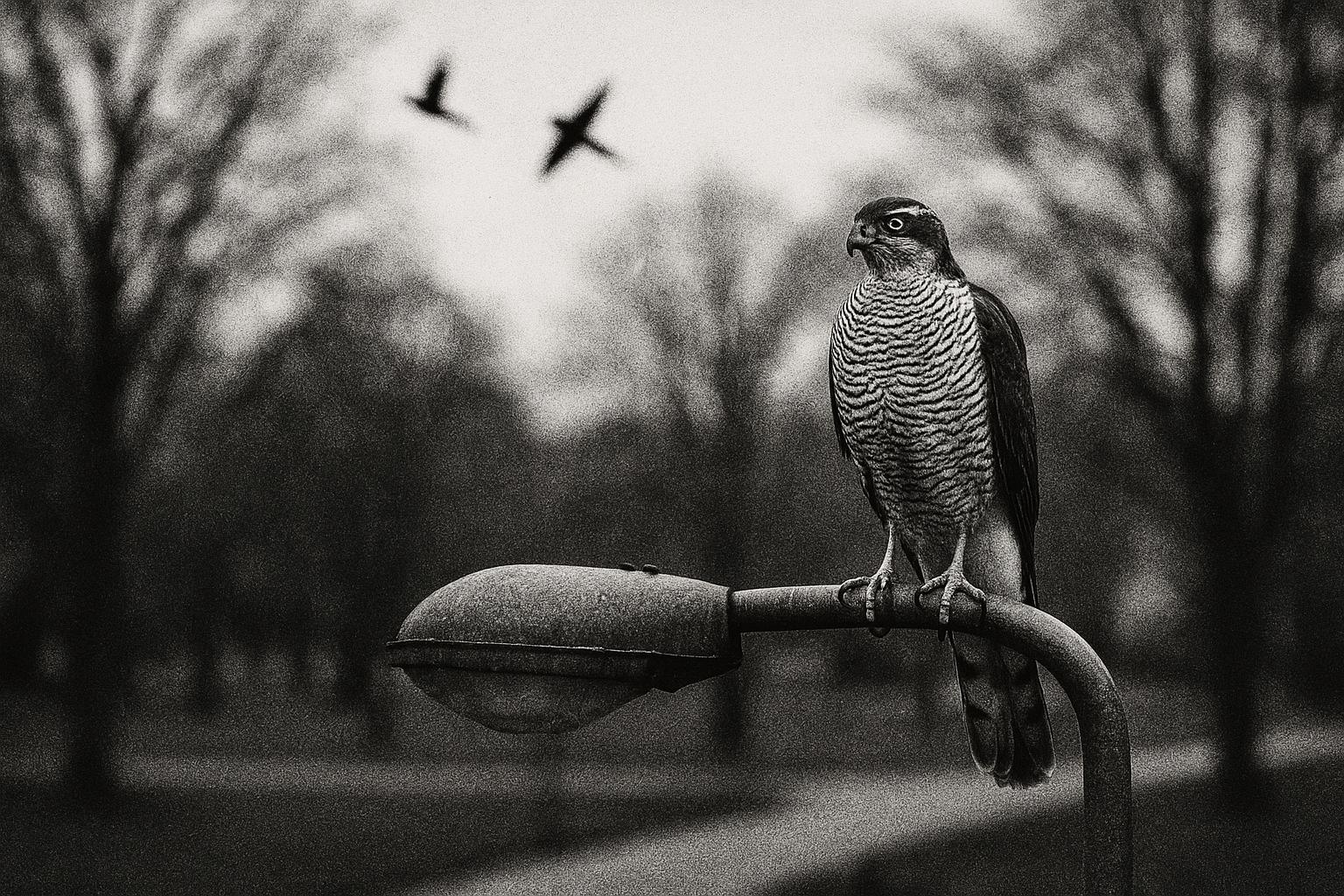Britain’s recovering goshawk population is spreading into suburban woodlands and parks, prompting experts to warn the powerful raptors may begin preying on established non‑native ring‑necked parakeets. Conservationists say the development could mirror peregrines’ recent urban dietary shifts, but emphasise careful monitoring to understand wider impacts on city ecosystems.
Britain’s thriving population of non‑native ring‑necked parakeets may soon face an unexpected new predator as goshawks — a powerful woodland raptor — extend their range and numbers. Conservationists and ornithologists say the birds of prey, once persecuted to near extinction in Britain, are recovering and dispersing into suburbs and the fringes of cities where parakeets are now abundant. According to the original report, experts suggest goshawks could begin to include parakeets in their diet in much the same way peregrine falcons already do. (The Mail on Sunday quoted Hazel Jackson of the UK Centre for Hydrology and Ecology saying goshawks “might take advantage” of parakeets as a food source.)
Ring‑necked parakeets are well established across southern Britain, especially in London and the south‑east. Natural History Museum research and past estimates from the British Trust for Ornithology indicate substantial numbers — the BTO has estimated roughly 12,000 breeding pairs, while post‑breeding counts have at times recorded more than 30,000 individual birds — and the species exploits parks, large gardens and mature trees for food and nesting. Their urban ecology — feeding on seeds, fruit and buds and nesting in cavities — makes them both conspicuous and resilient in built‑up areas. The Museum also notes that a range of native predators, from peregrines to sparrowhawks and tawny owls, already take parakeets on occasion, and that nest raid by grey squirrels can be a threat too.
There is precedent for rapidly adaptable urban raptors altering their diets when conditions change. A BBC study of peregrine falcons during the 2020 Covid lockdown found that as pigeon numbers in cities fell, peregrines shifted their prey mix — pigeons dropped from around half of observed prey to nearer 35 per cent, while parakeets rose to account for about 18 per cent. Researchers framed this as evidence of urban raptors’ dietary flexibility and their potential to exert local control over non‑native bird populations.
Goshawks themselves have an established history of recovery in Britain. The RSPB describes the species as a fast, agile woodland hunter that was largely wiped out by persecution but has recovered since the mid‑20th century; the BTO’s recent research reports the UK population increasing to more than a thousand breeding pairs and documents ongoing range expansion. Those recoveries are attributed in part to escapes and releases from falconry in the 1960s and 1970s and to legal protection since. The species’ principal prey in woodlands tends to be pigeons, corvids, squirrels and rabbits, but goshawks are opportunistic and hunt wherever dense cover and prey coincide.
Urban goshawks are not merely theoretical: across continental Europe they are already an urban presence. Reporting from Berlin and other cities shows goshawks exploiting parks, cemeteries and tree‑lined streets, taking advantage of plentiful pigeons, corvids and rodents and nesting in large trees. The Guardian’s feature on Berlin recounted how the city’s wooded structure supports unusually high densities — roughly a hundred pairs have been reported — illustrating that large, green urban spaces can sustain even apex avian predators.
Local sighting records and community reporting corroborate the impression of expansion around London. eBird alerts and regional records list recent goshawk reports from Surrey, West Sussex and marshland reserves on the Thames fringe, consistent with observers’ accounts of young dispersing birds exploring new habitats. Field ornithologists say such records are exactly the sort of early signs that precede more permanent colonisation of city suburbs if prey and nesting opportunities persist.
Not all experts assume an immediate, dramatic shift in predator–prey dynamics. Goshawks remain relatively secretive and prefer wooded areas, so their arrival in densely built inner‑city neighbourhoods is not guaranteed; RSPB guidance highlights that they favour large woods and are still vulnerable to illegal persecution and nest‑robbery. Nevertheless, some observers are cautious about the ecological implications: increasing goshawk numbers could help control superabundant pigeon and parakeet populations locally, but any change in predation pressure has knock‑on effects for other species and urban wildlife management.
Voices quoted in the original reporting emphasised both possibility and uncertainty. Conor Mark Jameson, author of Looking for the Goshawk, told The Mail on Sunday he expected goshawks to appear in parks around cities including London, Bath and Glasgow within a few years. Andy Evans of the RSPB told the same paper that “with continued protections” goshawks may become as familiar in London as they are in some European cities. BTO researchers and Natural History Museum scientists stress the need for continued monitoring to understand whether shifting distributions will translate into sustained predation on parakeets or only occasional, opportunistic feeding.
If goshawks do become more common in suburban and urban green spaces, managers face a familiar trade‑off: conserving a recovering native predator while assessing its effects on a well‑established non‑native species and on broader urban biodiversity. For now, experts urge careful, evidence‑based monitoring rather than alarm, noting that past studies of peregrines and real‑time records show how flexible urban food webs can be — and how rapidly they can change when a predator reappears.
 Reference Map:
Reference Map:
Reference Map:
- Paragraph 1 – [1], [4]
- Paragraph 2 – [2]
- Paragraph 3 – [3]
- Paragraph 4 – [4], [6]
- Paragraph 5 – [5]
- Paragraph 6 – [7]
- Paragraph 7 – [4], [2]
- Paragraph 8 – [1], [6], [4]
Source: Noah Wire Services
- https://www.dailymail.co.uk/news/article-14986021/predator-green-parakeet-population.html?ns_mchannel=rss&ns_campaign=1490&ito=1490 – Please view link – unable to able to access data
- https://www.nhm.ac.uk/discover/ring-necked-parakeets-in-london-and-uk.html – Natural History Museum explains that ring‑necked parakeets have established sizeable populations across Britain after repeated escapes and releases, thriving especially in London and the south‑east. Researchers traced their ancestry to Pakistan and northern India; the British Trust for Ornithology estimated about 12,000 breeding pairs, with earlier post‑breeding counts exceeding thirty thousand birds. The Museum notes parakeets exploit urban parks, gardens and mature trees, feeding on seeds, fruit and buds. Predators recorded taking parakeets include peregrine falcons, sparrowhawks and tawny owls, while grey squirrels may raid nests. The article highlights ecological concerns and the birds’ adaptability to urban environments and resilience.
- https://www.bbc.co.uk/news/uk-england-london-64786796 – The BBC reports research showing London’s peregrine falcons shifted their diet during the 2020 Covid lockdown, consuming a higher proportion of ring‑necked parakeets when urban pigeons became temporarily scarce. Study of nest camera footage across cities found pigeons fell from around fifty to thirty‑five per cent of prey, with parakeets rising to about eighteen per cent during the initial lockdown. The article notes peregrines now breed in urban locations and are adaptable predators that take a variety of birds. Researchers suggested these dietary changes illustrate the flexibility of urban raptors and their potential role in controlling non‑native bird populations locally.
- https://www.rspb.org.uk/birds-and-wildlife/bird-guides/birds-of-britain/goshawk/ – The RSPB outlines the goshawk as a powerful woodland raptor that was persecuted in Britain to near extinction but has recovered since the mid‑20th century. It describes their hunting style—fast, agile flights through trees—and lists common prey including pigeons, corvids, squirrels and rabbits. The page notes goshawks are secretive and mainly occupy large woods and forests, with strongholds in southern Scotland, northern England and Wales. Goshawks are protected under UK law and remain vulnerable to illegal persecution and nest‑robbery. The RSPB highlights that while not typically urban in the UK, goshawks can thrive where sufficient prey and nesting trees exist.
- https://www.theguardian.com/cities/2015/may/13/berlin-goshawks-urban-wildlife-tempelhof-airport-birdwatching – The Guardian’s feature describes Berlin as an unexpected stronghold for urban goshawks, with around one hundred pairs reported to breed within the city. It recounts how goshawks adapted to urban parks, cemeteries and tree‑lined streets, exploiting abundant prey such as feral pigeons, corvids and rats, and how they have become visible from terraces and public spaces. The piece explains Berlin’s wooded structure supports high goshawk densities and notes similar urban populations exist elsewhere in Europe. The article contrasts Britain’s largely woodland goshawks with those in continental cities, emphasising how urban green spaces can sustain even apex avian predators locally too.
- https://www.bto.org/our-work/news/press/where-goshawks-dare – The British Trust for Ornithology press release reports new research tracking goshawks and suggests the species’ range in the UK is expanding, with numbers rising to over a thousand breeding pairs. It explains goshawks were nearly wiped out by the early 1900s due to habitat loss, persecution and pesticides, and that a recovery followed from escaped and released falconry birds from the 1960s and 1970s. The release describes ongoing range expansion, scientific tracking of individuals and the possibility that increasing numbers could enable goshawks to colonise new habitats, including urban parks, if suitable prey and nesting sites are available.
- https://ebird.org/alert/rba/GB – The eBird United Kingdom Rare Bird Alert compiles recent confirmed records, showing goshawks reported in counties adjoining London such as Surrey and West Sussex and at coastal marshes and reserves. Regional alerts list specific occurrences at Ranmore Common and Rewell Wood and note occasional records from marshland sites and river edge reserves. Such community‑reported sightings corroborate increased observations at the edges of London and in Home Counties, supporting the suggestion that goshawks are being recorded more frequently in suburban and marshland habitats as their population expands and young dispersing birds explore new areas including along Thames margins and urban parks.
Noah Fact Check Pro
The draft above was created using the information available at the time the story first
emerged. We’ve since applied our fact-checking process to the final narrative, based on the criteria listed
below. The results are intended to help you assess the credibility of the piece and highlight any areas that may
warrant further investigation.
Freshness check
Score:
8
Notes:
The narrative appears to be recent, with no evidence of prior publication. The Daily Mail article was published on August 10, 2025, and no substantially similar content was found in recent searches. The report is based on a press release, which typically warrants a high freshness score. However, the lack of coverage by other reputable outlets within the past week suggests limited dissemination. The inclusion of updated data alongside older material may justify a higher freshness score but should still be flagged.
Quotes check
Score:
9
Notes:
The quotes attributed to Hazel Jackson and Conor Mark Jameson are not found in earlier material, indicating potential originality. However, without direct access to the original press release, it’s challenging to confirm the exclusivity of these quotes.
Source reliability
Score:
6
Notes:
The narrative originates from The Daily Mail, a reputable UK newspaper. However, the lack of corroboration from other reputable outlets raises questions about the reliability of the information. The report is based on a press release, which typically warrants a high freshness score but may not always indicate thorough journalistic investigation.
Plausability check
Score:
7
Notes:
The claim that goshawks may prey on ring-necked parakeets is plausible, given the goshawk’s recovery in Britain and its known predation on various bird species. However, the absence of supporting details from other reputable outlets and the lack of specific factual anchors in the narrative reduce the score. The tone and language used are consistent with typical journalistic reporting, but the lack of corroboration raises concerns.
Overall assessment
Verdict (FAIL, OPEN, PASS): OPEN
Confidence (LOW, MEDIUM, HIGH): MEDIUM
Summary:
The narrative presents a plausible claim about goshawks potentially preying on ring-necked parakeets, supported by quotes from experts. However, the lack of corroboration from other reputable outlets and the reliance on a press release without independent verification raise concerns about the information’s reliability. The absence of supporting details and specific factual anchors further diminishes confidence in the narrative’s accuracy.













